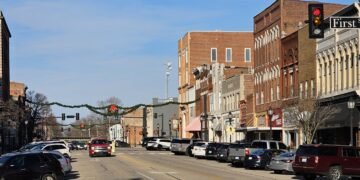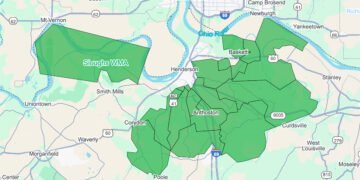(This article first appeared in the October print edition of the Hendersonian.)
Fall color is the main reason I enjoy autumn. Kentucky is a great place to view the brilliant yellow, vibrant orange, and deep purple colors that tree leaves provide. Natural areas like the Land between the Lakes and Pennyrile Forest are great places to see fall color, but it’s possible to get those same vibrant colors in your own backyard.
If you are looking to plant a tree for good fall color, one great tree choice for fall color are sugar maples which generally have a golden yellow color will change to orange or red. Other brilliant yellow trees are the ginkgo, sweet gum, and our state tree, the tulip poplar. Planting under power lines can limit your choices however. One great choice with lots of color, for smaller lawns and near power lines, is the serviceberry. Besides the yellow or reddish fall color, the serviceberry is also a native and produces edible fruit. The best time to plant trees is after the first frost and before the last frost in the spring.
Although it is easy to find the changing colors of autumn, have you ever considered what is really happening to the leaves and why some trees turn yellow and others turn red? For most of the year, most trees are green. Leaves contain a pigment called chlorophyll which reflects green light and gives leaves their color. Chlorophyll is used by plants to absorb energy from sunlight to produce food for growth—a process called photosynthesis. This process continually uses up chlorophyll; therefore, the plant must replenish this pigment throughout the growing season. As long as chlorophyll is replaced by the plant, the leaves stay green. As days become shorter and temperatures become cooler, trees detect the change and the production of chlorophyll slows down and eventually stops.
Carotene and xanthophyll are pigments produced in some foliage along with chlorophyll. These pigments help plants by increasing the amount of light a plant can absorb. Although they are present, chlorophyll is the more dominant pigment, and carotene and xanthophyll pigments go unnoticed during the year. That is until the supply of chlorophyll dwindles in the fall and the other pigments are unmasked and show through. These two pigments reflect orange and yellow light and explain why trees like sugar maple, birch, beech, ginkgo, tulip poplar and sassafras change to these colors in the fall.
For trees like red maple, dogwood, sweetgum and oaks to develop their red and purple fall colors, another group of pigments is needed. This group is called anthocyanins and unlike the previously mentioned pigments, they are not present year-round in leaves. Anthocyanins are produced by some trees when an abundance of sugars accumulate in leaves as a response to cool nights and sunny days. The brighter the sunlight during the fall, the more anthocyanins are produced and the more vibrant the red color in trees.
Intensity and quality of fall color vary each year. Fall color is very dependent on weather conditions occurring before and during the time when chlorophyll is declining. Cool night-time temperatures are ideal for fall color development. A mild drought in early fall can also intensify red color in leaves. Early frosts, rainy days, and warm or freezing fall temperatures all decrease the color intensity of fall. Because fall color is dependent on temperatures, sunlight, and moisture it is difficult to predict fall color intensity and peak color during the year; the only sure assumption being that no two autumns are alike.
Take some time to enjoy the trees this fall and as always, if you have questions, we have answers. Contact us at the Henderson County Extension Office; we are happy to help!
P. Andrew Rideout is the UK Extension Agent for Horticulture and can be reached at pandrewrideout@uky.edu.





















